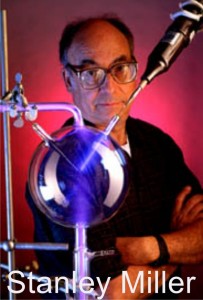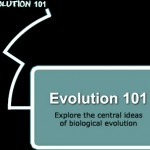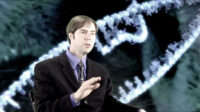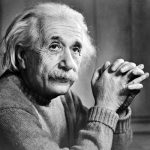
Why Evolution is True, one of the best-selling books in support of evolution written by Jerry Coyne and endorsed by Richard Dawkins, conveniently fails to address one minor evolutionary issue—the origin of life problem. Charles Darwin had been stonewalled by this problem, too, in The Origin of Species.
In the mid twentieth century, using a simple laboratory experiment, Stanley Miller (pictured left) and Harold Urey (pictured right) were the first to demonstrate how life may have started from simple molecules and energy. In the excitement, addressing the scope of the Miller-Urey probability issue was postponed.
The Stanley-Miller origin of life model was once the most popular theory, dating back to the publication of “The Planets: Their Origin and Development” in 1952. Written by Harold Urey, the book speculates that life originated in early Earth’s atmosphere, composed of ammonia, methane, and hydrogen—a reducing atmosphere without oxygen.
Urey Model
Harold Urey was awarded the Nobel Prize in Chemistry in 1934 for his work on isotopes. During World War II, Urey directed the Manhattan Project at Columbia University, which led to the development of the atomic bomb.
Urey’s model for the origin of life, however, was published without testing the results. When challenged by his graduate student, Stanley Miller, they performed the now-famous Miller–Urey experiment.
After assembling a closed glass apparatus in Urey’s laboratory, Miller pumped out the air and replaced it with methane, ammonia, hydrogen, and water, creating a reducing atmosphere—without oxygen—a gas composition resembling the atmosphere of Jupiter. With electrical charges, Miller reported
“By the end of the week, [the resulting solution] “was deep red and turbid.”
Just as Urey had predicted, chemical analysis of the resulting tar solution revealed several organic compounds, including glycine and alanine, the two simplest amino acids found in proteins—the building blocks of life. With amino acids spontaneously arising in early Earth’s atmosphere, the ensuing amino acid chance interactions forming into proteins became recognized as the natural mechanism to explain the origin of life.
Proof of Concept
Without a statistical Miller-Urey probability analysis, a reference to the M iller–Urey experiment quickly found its way into science textbooks. According to Evolution 101, sponsored by the University of California, Berkeley
iller–Urey experiment quickly found its way into science textbooks. According to Evolution 101, sponsored by the University of California, Berkeley
“These experiments serve as ‘proofs of concept’ for hypotheses about steps in the origin of life — in other words, if a particular chemical reaction happens in a modern lab under conditions similar to those on early Earth, the same reaction could have happened on early Earth and could have played a role in the origin of life. The 1953 Miller-Urey experiment, for example, simulated early Earth’s atmosphere with nothing more than water, hydrogen, ammonia, and methane and an electrical charge standing in for lightning, and produced complex organic compounds like amino acids.”
Since 1953, however, extensive investigations have demonstrated that the Earth’s atmosphere was not composed of ammonia, methane, and hydrogen. Rather than the anticipated reducing atmosphere, the Earth’s atmosphere was the opposite—an oxygen-rich atmosphere, like our current atmosphere.
Miller-Urey Probability
Evolution 101, acknowledging atmosphere problems with the Miller-Urey experiment, adds –
“Now, scientists have learned more about the environmental and atmospheric conditions on early Earth and no longer think that the conditions used by Miller and Urey were quite right… These experiments yielded similar results – complex molecules could have formed in the conditions on early Earth.”
While the formation of amino acids in the early atmosphere of the Earth is generally not considered a valid theory, what is the probability of complex molecules arising by chance?
Evolution 101 uses the word “could” to explain the potential development of complex molecules on Earth. The fundamental question, however, is beyond “could.” The question centers on the “probability” of complex protein molecules forming by chance alone from amino acids. Any event “could” happen, but not all events are “probable.”
Proteins consist of amino acids linked by peptide bonds. Since amino acids have roughly a 50:50 chance of forming peptide bonds to another amino acid, the probability of 4 amino acids forming a peptide bond together is ½ X ½ X ½ X ½ = 1/16, or (1/2)4.
Since a simple protein usually consists of a chain of 150 amino acids, the probability of forming the chain is (1/2)150, or roughly 1 chance in 1045. That is the number 10 with 45 trailing zeros.
Given that each amino acid has a mirror image, there is one left-handed and the right-handed version for each amino acid, the probability of forming one simple protein from 150 amino acids is 1 chance in 1090.
 One of the most important functional aspects of a protein is the sequence of amino acids. Since there are 20 biologically active amino acids, the probability of amino acids occurring in a functional protein is (1/20)150, or roughly 1 chance in 10195. The calculated Miller-Urey probability, therefore, excludes the event as a result of chance.
One of the most important functional aspects of a protein is the sequence of amino acids. Since there are 20 biologically active amino acids, the probability of amino acids occurring in a functional protein is (1/20)150, or roughly 1 chance in 10195. The calculated Miller-Urey probability, therefore, excludes the event as a result of chance.
Origin of life scientist Stephen C Meyer (pictured left), in Signature in the Cell, gives a perspective on the probability of finding one functional protein in the universe –
“Another way to say that is the probability of finding a functional protein by chance alone is a trillion, trillion, trillion, trillion, trillion, trillion, trillion times smaller than finding a specified particle among all the particles in the universe.”
Jerry Coyne (pictured right) and Richard Dawkins discreetly circumvent the origin of life issues since the event probability was not by chance. Meyer concludes,
“For this reason, it would be vastly more probable than not that a protein function would not have arisen by chance.”
The evidence contradicts the central tenet of the theory of evolution—life by chance. Darwin’s Dilemma intensifies.
Genesis
 The Genesis account written by Moses is compatible with the scientific evidence. Meyer’s assessment aligns with Albert Einstein’s famous dictum during the Scientific Revolution:
The Genesis account written by Moses is compatible with the scientific evidence. Meyer’s assessment aligns with Albert Einstein’s famous dictum during the Scientific Revolution:
“God does not play dice with the universe.”
Evidence from molecular biology underscores why the theory of evolution remains speculative but not scientifically valid.
Miller-Urey Origin Probability is an Origin of Life article.
Darwin Then and Now is an educational resource on the intersection of evolution and science, highlighting the ongoing challenges to the theory of evolution.
Move On
Explore how to understand twenty-first-century concepts of evolution further using the following links –
-
- The Understanding Evolution category showcases how varying historical study approaches to evolution have led to varying conclusions. Subcategories include –
- Studying Evolution explains how key evolution terms and concepts have changed since the 1958 publication of The Origin of Species.
- What is Science explains Charles Darwin’s approach to science and how modern science approaches can be applied to different investigative purposes.
- Evolution and Science feature study articles on how scientific evidence influences the current understanding of evolution.
- Theory and Consensus feature articles on the historical timelines of the theory and Natural Selection.
- The Biography of Charles Darwin category showcases relevant aspects of his life.
- The Glossary defines terms used in studying the theory of biological evolution.
- The Understanding Evolution category showcases how varying historical study approaches to evolution have led to varying conclusions. Subcategories include –


